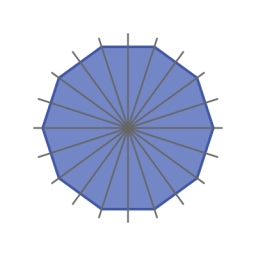Decadal - flower bed
The castle park includes a flower bed in the shape of a regular decagon with an area of 432.8 m2. Determine the distance between the adjacent vertices of the flower bed.
Final Answer:

Tips for related online calculators
See also our right triangle calculator.
Do you want to convert area units?
See also our trigonometric triangle calculator.
Try conversion angle units angle degrees, minutes, seconds, radians, grads.
Do you want to convert area units?
See also our trigonometric triangle calculator.
Try conversion angle units angle degrees, minutes, seconds, radians, grads.
You need to know the following knowledge to solve this word math problem:
algebraarithmeticplanimetricsgoniometry and trigonometryUnits of physical quantitiesGrade of the word problem
We encourage you to watch this tutorial video on this math problem: video1
Related math problems and questions:
- A park
 In a park, the breadth of a rectangular flower bed is 2.25m, and its length is four times its breadth. Find the area of the rectangle.
In a park, the breadth of a rectangular flower bed is 2.25m, and its length is four times its breadth. Find the area of the rectangle. - Flower bed
 The park has a rectangular flower bed with dimensions of 3.2m and 1.5m. How many rose bushes will we plant in the flower bed if 20 dm² are needed for one bush?
The park has a rectangular flower bed with dimensions of 3.2m and 1.5m. How many rose bushes will we plant in the flower bed if 20 dm² are needed for one bush? - Flowerbed 2
 Around the square flower bed in a park is a sidewalk about 1.3 m wide. The area of this sidewalk is 246 m². What is the area of the flowerbed?
Around the square flower bed in a park is a sidewalk about 1.3 m wide. The area of this sidewalk is 246 m². What is the area of the flowerbed? - Which
 Which of the following numbers is the most accurate area of a regular decagon with side s = 2 cm? (A) 9.51 cm² (B) 20 cm² (C) 30.78 cm² (D) 31.84 cm² (E) 32.90 cm2
Which of the following numbers is the most accurate area of a regular decagon with side s = 2 cm? (A) 9.51 cm² (B) 20 cm² (C) 30.78 cm² (D) 31.84 cm² (E) 32.90 cm2 - CoG center
 Find the position of the center of gravity of a system of four mass points having masses, m1, m2 = 2 m1, m3 = 3 m1, and m4 = 4 m1, if they lie at the vertices of an isosceles tetrahedron. (in all case
Find the position of the center of gravity of a system of four mass points having masses, m1, m2 = 2 m1, m3 = 3 m1, and m4 = 4 m1, if they lie at the vertices of an isosceles tetrahedron. (in all case - Circumference 7143
 Peter drew a regular hexagon, the vertices of which lay on a circle 16 cm long. Then, for each vertex of this hexagon, he drew a circle centered on that vertex that ran through its two adjacent vertices. The unit was created as in the picture. Find the ci
Peter drew a regular hexagon, the vertices of which lay on a circle 16 cm long. Then, for each vertex of this hexagon, he drew a circle centered on that vertex that ran through its two adjacent vertices. The unit was created as in the picture. Find the ci - Components 2565
 The component is a regular decagon with a side of 2 cm. Its material weight of 1 m² of sheet metal is 24 kg. What is the weight of 200 components?
The component is a regular decagon with a side of 2 cm. Its material weight of 1 m² of sheet metal is 24 kg. What is the weight of 200 components?
